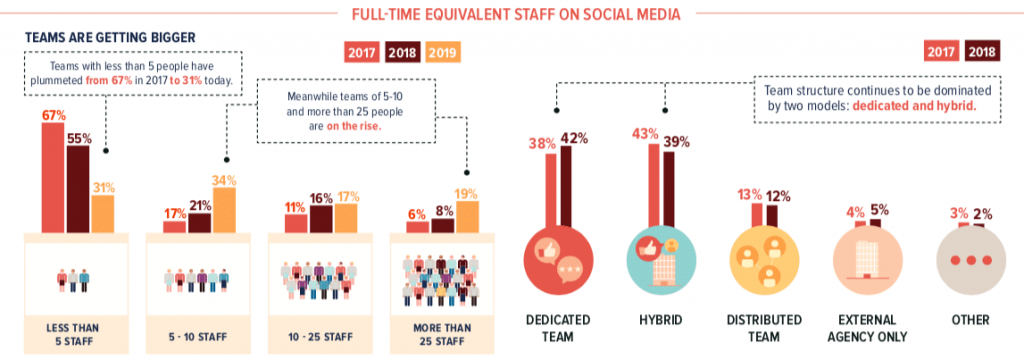For the past eight years, SimpliFlying has surveyed airline professionals globally to get their perspectives on the present and the future of social media’s impact on the industry. We publish our findings based on the survey in our annual Social Media Outlook Report. Below you can read an excerpt from this year’s report.
To understand how airlines are using social media, we always start with one thing: the people. Because the way an airline distributes its human resources can tell us a lot about its priorities, challenges and needs. Interestingly, this year’s findings show the continued dominance of hybrid and dedicated team structures which is in line with what we saw in previous years.
Dedicated social media teams are specialized groups that operate within the airline and can provide very good integration with all of the airline’s functions. They are especially efficient for larger airlines that have economies of scale to support them. In smaller airlines, this structure is sometimes found in the form of a few dedicated individuals who are in charge of all the airline’s social media operations.
Download the full infographic here.
The biggest advantage of having a dedicated team inside the airline is agility. This can be the key in providing good social customer service and coming out on top during a crisis. Some of the SimpliFlying Awards’ top winners over the years like American Airlines have dedicated teams.
At American Airlines, there are over 20 full-time social media staff that deal with both social care and content marketing. What makes American Airlines stand out is that the staff on the social media team have been at the airline for an average of 18 years!
While recruiting for the team, the airline chose experience in handling situations rather than familiarity with tools. Due to this, American Airlines can boast a high issue resolution rate on social media, not just a short average reply time.
The airline’s dedicated team structure has also allowed it to create processes that has allowed it to release a statement from the CEO within 20 minutes of a crisis erupting on Twitter.
Dedicated social media teams, while resource intensive, offer the best long-term value for airlines.
Why are hybrid teams still popular?
Hybrid teams are those that mix a specialized internal team with external resources and are the structure of choice for airlines on a budget and those that may need to scale up or down quickly. For example, a team of two social media team staff may be complemented by a point person from Corporate Communications, Customer Care and eCommerce each.
For small airlines, this structure may be the only option. They don’t have the economies of scale needed for a dedicated team when it comes to providing 24 hours of customer service. This is also a very flexible option that is often found in airlines that are scaling up their operations or who have experienced fast growth.
At larger airlines, the hybrid teams make less sense but can sometimes provide advantages to reach markets where the airline has a limited presence. For example, South African Airways has a hybrid structure. There is a core social media team based in Johannesburg, the headquarters, which is complemented by point people in each of the outstation offices. While the core team decides on the overall strategy, the local teams have the autonomy to customize the messages and channels for each campaign. This allows the brand to adapt to each market, while still reflecting a coherent social media strategy.
While the hybrid team structure provides flexibility, it is slower to respond to changes and deprives the airline of potentially useful information. This is because everything needs to often be approved by the core social media team. This is especially true in times of crises where tight coordination with Operations and early warnings from social media monitoring teams can make all the difference.
For either of these structures to be efficient, the challenge is always good communication across departments. This is especially true on the customer service front. The airline needs to identify problems before they snowball out of control and can also seize opportunities for marketing. However, this can only happen if their team is able to pass on the information to the right people quickly.
At the same time, customer service teams can greatly benefit from integration with operations. As we will see later on, this topic is high on the priority list of airline managers and executives. Download our Social Media Outlook Report 2019 to continue reading or email me at marco@simpliflying.com to help you structure your social media team.

